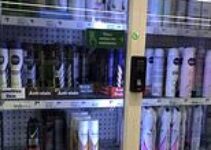The smoke is has cleared from New York City earlier this month, but it’s now rolling into Chicago.
Wildfire haze has got many people thinking about how they will protect themselves from polluted air in the future. Air purifiers can help, but most people need to leave their homes at some point, and they’re looking for technology they can take with them.
The terrible air quality in much of the Northeast earlier this month and in the Midwest this week is a direct result of Canadian wildfires, and has some people considering Dyson’s $900 air-purifying mask-and-headphone combination.
Twitter user @Rjey tweeted that “only Dyson can save us from Toronto’s terrible air pollution” along with an image of a model wearing the Dyson Zone headset.
When the headset came out at the end of last year, reviewers expressed doubt that anyone would wear it in public because of its clunky look, its weight and the less-than-perfect volume control on its headphones.
Read: When will the smoke clear? Canadian wildfires could impact U.S. air quality for days.
“Air pollution due to the spread of wildfires is unfortunately our new reality. Maybe Dyson was right to think that this type of wearable tech really is our future,” Esquire senior commerce editor Krista Jones wrote about her change in perspective after her partner tested the Dyson Zone earlier this month. Jones’s partner said using the headphones “was like walking about with a personal air purifier.”
The Dyson Zone claims to remove 99% of pollutants as small as 0.1 microns and also to filter out gases, according to its product page, and it can connect to a mobile app for real-time air-quality updates. Dyson did not respond to a request for comment.
Small particles that are less than 2.5 microns in diameter are of particular concern when it comes to air pollution’s effects on health, researchers say. Exposure can cause inflammation and weaken the immune system and is also linked to a risk of chronic lung and respiratory disease.
So as climate change makes more wildfires likely, more people may start masking again. But there are cheaper ways to do it than the Dyson Zone.
What are some other high-tech options?
For those who are looking for a high-tech mask, also known as a personal respirator, Dyson’s offering is neither the first nor the cheapest. A few brands, some based in Asia, have been focusing on smart personal respirators for several years already, and consumers have turned to them in areas where smog and air pollution are a frequent problem. People living in California and in countries including China, India and Singapore, for example, have been dealing with poor air quality caused by wildfires, agricultural burning or industrial emissions for years.
Also read: I grew up with hazardous smoke from forest fires in Asia. Here’s what I learned.
While some cheaper models incorporate headphones like the Dyson Zone does, most focus on good air filtering and purification and on air-flow management.
The best-selling air-purifying masks on Shopmask — a global online retailer that launched in early 2020 to help meet the demand for masks at the start of the pandemic — are the Philips Fresh Air Mask and the LG PuriCare Wearable Air Purifier, according to information the company provided to MarketWatch.
Both the Philips
PHG,
and LG
066570,
models are battery-powered and offer active air filtering, an important feature for users who dislike the buildup of humidity caused by common masks, the company told MarketWatch.
The LG PuriCare, which costs $289 on Shopmask, claims to filter up to to 99.7% of particles, while the Philips model, which is sourced from Japan, costs $199 and filters out 95% of particles.
The site also sells personal respirators from brands such as Woobi Plus and Blovx Sphyrna, most of which are priced under $100. The masks are primarily sought out by people who take part in intensive workouts or sports activities, according to the website.
The cheapest option? Our old friend the N95.
The best way to avoid inhaling smoke caused by wildfires is to stay inside, officials have noted. But when people need to be outdoors in smoky conditions, the California Department of Public Health advises using N95 respirator masks, which are designed to filter out 95% of particles 0.3 microns or larger. These are deemed by experts to be the most effective masks that most people have access to.
N95 disposable masks cost around $10 for a 10-pack on Amazon
AMZN,
Among those who are most vulnerable to air pollution are low-income people, homeless people or people who work outdoors.
People with medical conditions such as chronic respiratory disease or heart disease may find that wearing an N95 mask can make breathing difficult. They should check with their healthcare providers about recommended options, according to the Food and Drug Administration website.
But even the best-performing masks don’t work well if they don’t fit correctly. Many commercially available masks might not provide adequate protection against particulate air pollution for that reason, studies have shown.
For more context: ‘We need an equity approach to the climate crisis’: When air quality declines, low-income people and communities of color suffer most.


